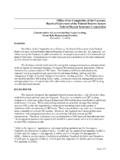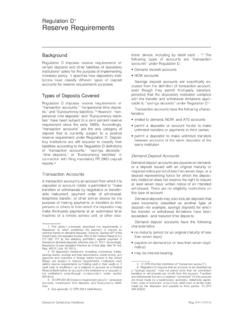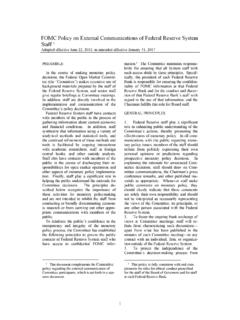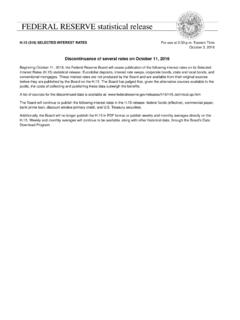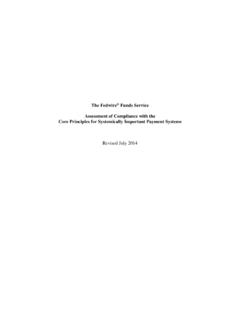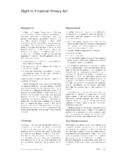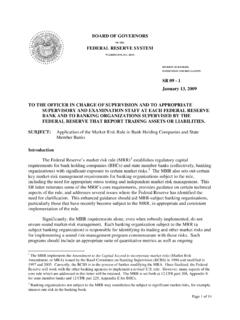Transcription of The Beige Book - federalreserve.gov
1 The Beige Book Summary of Commentary on Current Economic Conditions By Federal Reserve District For use at 2:00 PM EDT Wednesday October 20, 2021 October 2021 Federal Reserve Districts Boston New York Philadelphia Cleveland Chicago Richmond Atlanta St. Louis Kansas City Dallas Minneapolis San Francisco The System serves commonwealths and territories as follows: the New York Bank serves the Commonwealth of Puerto Rico and the Virgin Islands; the San Francisco Bank serves American Samoa, Guam, and the Commonwealth of the Northern Mariana Islands. Alaska and Hawaii are part of the San Francisco District. This report was prepared at the Federal Reserve Bank of Richmond based on information collected on or before October 8, 2021. This document summarizes comments received from contacts outside the Federal Reserve System and is not a commentary on the views of Federal Reserve officials.
2 National Summary 1 Boston A-1 First District New York B-1 Second District Philadelphia C-1 Third District Cleveland D-1 Fourth District Richmond E-1 Fifth District Atlanta F-1 Sixth District Chicago G-1 Seventh District St. Louis H-1 Eighth District Minneapolis I-1 Ninth District Kansas City J-1 Tenth District Dallas K-1 Eleventh District San Francisco L-1 Twelfth District What is the Beige Book? The Beige Book is a Federal Reserve System publication about current economic conditions across the 12 Federal Reserve Districts. It charac-terizes regional economic conditions and prospects based on a variety of mostly qualitative information, gathered directly from each District s sources. Reports are published eight times per year. What is the purpose of the Beige Book? The Beige Book is intended to characterize the change in economic conditions since the last report.
3 Outreach for the Beige Book is one of many ways the Federal Reserve System engages with businesses and other organizations about economic developments in their communi-ties. Because this information is collected from a wide range of con-tacts through a variety of formal and informal methods, the Beige Book can complement other forms of regional information gathering. The Beige Book is not a commentary on the views of Federal Reserve officials. How is the information collected? Each Federal Reserve Bank gathers information on current economic conditions in its District through reports from Bank and Branch direc-tors, plus interviews and online questionnaires completed by business-es, community organizations, economists, market experts, and other sources. Contacts are not selected at random; rather, Banks strive to curate a diverse set of sources that can provide accurate and objective information about a broad range of economic activities.
4 The Beige Book serves as a regular summary of this information for the public. How is the information used? The information from contacts supplements the data and analysis used by Federal Reserve economists and staff to assess economic condi-tions in the Federal Reserve Districts. The qualitative nature of the Beige Book creates an opportunity to characterize dynamics and identi-fy emerging trends in the economy that may not be readily apparent in the available economic data. This information enables comparison of economic conditions in different parts of the country, which can be helpful for assessing the outlook for the national economy. The Beige Book does not have the type of information I m looking for. What other information is available? The Federal Reserve System conducts a wide array of recurring sur-veys of businesses, households, and community organizations. A list of statistical releases compiled by the Federal Reserve Board is available here, links to each of the Federal Reserve Banks are available here, and a summary of the System s community outreach is available here.
5 In addition, Fed Listens events have been held around the country to hear about how monetary policy affects peoples daily lives and liveli-hoods. The System also relies on a variety of advisory councils whose members are drawn from a wide array of businesses, non-profit organizations, and community groups to hear diverse perspectives on the economy in carrying out its responsibilities. 1 National Summary Highlights by Federal Reserve District Overall Economic Activity Economic activity grew at a modest to moderate rate, according to the majority of Federal Reserve Districts. Several Districts noted, however, that the pace of growth slowed this period, constrained by supply chain disruptions, labor shortages, and uncertainty around the Delta variant of COVID-19. A majority of Districts indicated positive growth in consumer spending; however, auto sales were widely reported as declining due to low inventory levels and rising pric-es.
6 Travel and tourism activity varied by District with some seeing continued or strengthening leisure travel while others saw declines that coincided with rises in COVID cases and the start of the school year. Manufacturing grew moderately to robustly in most parts of the country, as did trucking and freight. Growth in nonmanufacturing activity ranged from slight to moderate for most Districts. Loan demand was generally reported as flat to modest this period. Residential real estate activity was unchanged or slowed slightly but the market remained healthy, overall. Reports on nonresidential real estate varied across Districts and market segments. Agriculture conditions were mixed and energy markets were little changed, on balance. Outlooks for near-term economic activity remained positive, overall, but some Districts noted increased uncertainty and more cautious optimism than in previous months.
7 Employment and Wages Employment increased at a modest to moderate rate in recent weeks, as demand for workers was high, but labor growth was dampened by a low supply of workers. Transportation and technology firms saw particularly low labor supply, while many retail, hospitality, and manufacturing firms cut hours or production because they did not have enough workers. Firms reported high turnover, as workers left for other jobs or retired. Child-care issues and vaccine mandates were widely cited as contributing to the problem, along with COVID-related absences. Many firms offered increased training to expand the candidate pool. In some cases, firms increased automation to help offset labor short-ages. The majority of Districts reported robust wage growth. Firms reported increasing starting wages to attract talent and increasing wages for existing workers to retain them. Many also offered signing and retention bonuses, flexible work schedules, or increased vacation time to incentivize workers to remain in their positions.
8 Prices Most Districts reported significantly elevated prices, fueled by rising demand for goods and raw materials. Reports of input cost increases were widespread across industry sectors, driven by product scarcity resulting from supply chain bottlenecks. Price pressures also arose from increased transportation and labor constraints as well as commodity shortages. Prices of steel, electronic components, and freight costs rose markedly this period. Many firms raised selling prices indicating a greater ability to pass along cost increases to customers amid strong demand. Expectations for future price growth varied with some expecting price to remain high or increase further while others expected prices to moderate over the next 12 months. Boston Business activity in the First District expanded at a mod-est to moderate pace in August and September 2021. Wages increased moderately as firms competed for scarce workers.
9 Retailers and manufacturers posted moderate to steep price increases amid ongoing supply disruptions. The outlook was cautiously optimistic. New York Growth in the regional economy slowed to a modest pace in recent weeks, as supply disruptions and labor shortages have impeded economic activity. Employment and wages increased. Businesses reported ongoing widespread escalation in both input costs and selling prices. Despite the slowdown, contacts continued to express optimism about future business prospects. The Beige Book October 2021 2 National Summary Philadelphia Business activity grew modestly during the curre nt Beige Book perio d slower than the prior period but re-mained below pre-pandemic levels. Fear and uncertainty of the Del ta variant continued to constrain growth, but contacts were most worried by ongoing labor shortages and supply chain disruptions. Overall, employment con-tinued to grow modestly, whil e wages and prices contin-ued to rise at a moderate pace.
10 Cleveland Economic activity remained strong in the District. While demand was still solid , supply chain disruptions tem-pered the pace of sales and output growt h. The expira-tion of s upplemental unemployment insurance benefits and a return to school did little to alleviate worker short-ages, and wages continued to ris e. This and higher nonlabor input costs put further upward pressure on selling prices. Richmond The regional economy increased at a modest rate as growth was constrained by labor shortages and short-ages and delays receiving goods and raw materials needed for business. Employers across sectors had difficulties finding and keeping workers, which led to offering higher wages and bonuses to recruit and retain staff. Prices remained elevated compared to year-ago levels. Atlanta Economic activity expanded moderately. Labor markets remained tight and wage pressures intensified.
